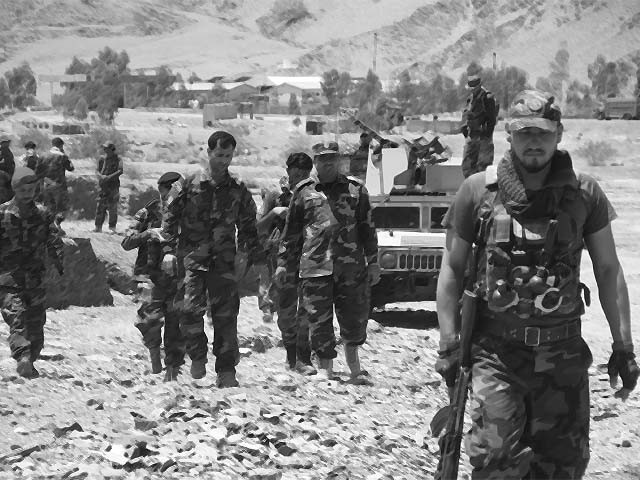The Taliban’s quest to take over Afghanistan saw another twist in the eventful tale of the Kandahari town Spin Boldak, overseeing the border with Pakistan’s Balochistan province. The white desert after which the town is named has seen its fair share of bloodshed in the last few decades: Spin Boldak has played an important role in the recent history of Afghanistan-Pakistan relations, the Taliban movement, and clan-related conflict.
A strategic post
Spin Boldak sits a stone’s throw away from the Pakistani town Chaman, a largely Pakhtun settlement whose population has boomed in the last few decades with refugees and militants alike from Afghanistan. During and between the Soviet and American invasions of Afghanistan, Spin Boldak and Chaman derived importance from this proximity, the importance to the border for smugglers, and the fact that insurgents from one country could recuperate and reorganize in the other. The region is also home to a number of major Pakhtun clans, and in unison with the recent wars has seen considerable competition between the Achakzai and Nurzai clans that plays into and is played upon by the wider war.
Spin Boldak during the Soviet invasion
During the Soviet invasion of Afghanistan, Spin Boldak was the stronghold of flamboyant Achakzai adventurer Ismatullah Muslim, who founded the militia ostensibly to fight the Soviet-backed regime before joining it. Sadistic, unscrupulous, and fiercely autonomous, the common denominator in Ismatullah’s career was his autonomy and the importance he placed in extracting Spin Boldak’s strategic location for his Achakzai fighters’ interests.
Because support to the Afghan insurgency required enlistment in one of the Peshawar-based mujahideen parties, Ismatullah – a former airforce officer who had once fallen foul of the Soviet Union for professional indiscipline – grudgingly joined the royalist Mahaz party led by the Sufi Gaillani family. In 1984 he switched sides and joined the regime, who promoted him to commander for not only Spin Boldak but increasingly the rest of Kandahar. This brought with it disastrous, bloody feuding against insurgent fronts that took on a clan nature.
The Afghan regime had little more luck in controlling Ismatullah than their opponents had – he was put under a brief house arrest after a shootout, but by 1988 he had been released in order to confront an insurgent attack on Spin Boldak. The insurgents were split over how to deal with the militia; the Mahaz party favoured cutting a deal, but Sarkatib Atta from the Hizb party favoured an attack. Throughout the summer, Atta attacked the Achakzai militia. But with little success and the war winding down the Pakistani liaison with the insurgency, Raza Ali, instead backed Ismatullah’s opponents from the Nurzai clan. Led by Ghulam Farouq, they succeeded in driving the Achakzai militia from its lair.
Spin Boldak in between occupations
Mujahideen-communist distinctions blurred in the civil war that accompanied the regime’s downfall in April 1992. In such provinces as Kandahar, a safe distance from the civil war’s epicentre at Kabul, militias freed of central oversight and requiring funds to operate largely turned to banditry of the sort for which the Achakzai militia was reknowned. With Ismatullah having succumbed to a sickness, his cousin Mansur Khan took over a militia that was now one among many in the area.
The misrule that followed, whose side-effects included inconveniencing Pashtun merchants on the border, helped provoke a revolt by Islamic students into the Taliban movement. These networks had been mobilising for some months when in October 1994 Pakistani interior minister Naseerullah Babar, trying to open a trade route into Central Asia, led a convoy across the border that was promptly waylaid at Spin Boldak by militia commanders including Mansur and, ironically enough, Pakistan’s old Hizb partner Atta. They were rescued, however, when a Taliban force swooped in and scattered the militias, before going on and seizing Kandahar city. Thus Spin Boldak played a major role in the foundation of the Taliban emirate, as well as Pakistani support – an impressed Babar, who had trained Afghan militants, proudly if misleadingly hailing the movement as “our boys”.
The Taliban loathed Ismatullah’s militia – they famously hung the corpse of Mansur Khan off a tank in order to intimidate other militias – and this was particularly compounded for the emirate’s Nurzai commanders, with sheriff Hafiz Abdul-Majeed reportedly excavating Ismatullah’s grave. Spin Boldak’s garrison was entrusted to another Nurzai commander, Hafiz Abdul-Rahim, a veteran of the Nurzai front that had captured the town from Ismatullah in 1988.
Spin Boldak under America: The militia revived
The United States’ campaign hinged on supporting various militias against the Taliban emirate. In northern Afghanistan, organised opposition had been bubbling for years, but in the south long-inactive militia commanders jumped at their chance. Among the most prized such commanders was Abdul-Raziq Khan, a kinsman of Ismatullah and Mansur, who reactivated the militia in support of the American march on Kandahar. Inheriting Ismatullah’s combination of charisma and cruelty, he would become the Americans’ most prized and controversial vassal in the south.
In November 2001 Abdul-Raziq and the Americans bulldozed through Spin Boldak, brushing aside Hafiz Abdul-Rahim before their march on Kandahar. Back in the ascendancy and armed with American orders to capture or kill Taliban fighters, the Achakzai militia eagerly set about persecuting Spin Boldak’s Nurzai community as Taliban sympathizers. This vindictive behaviour played a major role in provoking Taliban fighters, many of whom had retired after the emirate’s downfall, into insurgency. For Spin Boldak’s Nurzai, it seemed to have become nearly a matter of survival.
Just as Spin Boldak had been the first scene of the Taliban emirate in 1994, it became the launchpad of the war against the United States. Though the insurgency was not exactly a clan-specific phenomenon – their leading commander at Spin Boldak, Taliban interior minister Abdul-Razzaq Akhundzada, also belonged to the Achakzai clan – they certainly benefited from Nurzai grievances against the Achakzai militia. A disproportionate number of their commanders in Kandahar were Nurzais; these included both Abdul-Rahim, who lost his life in combat, and Abdul-Majeed. Abdul-Raziq’s predation reinforced their narrative that the invasion had brought a return of corruption and abuse.
Old patterns repeated themselves. Much as the communists had promoted Ismatullah beyond Spin Boldak to Kandahar province in the 1980s, so did Canadian troops in 2006 and American troops in 2010 with Abdul-Raziq. On each occasion, such Taliban Nurzai commanders as Abdul-Majeed galvanised their community to fight the militia’s encroachment.
That he was nonetheless persisted with spoke to not only the United States’ uses for Abdul-Raziq, but also Kabul’s. As in the 1980s, Afghan intelligence had quietly harboured Baloch ethnonationalists waging a low-scale insurgency against Pakistan, who in turn harboured the Taliban at Quetta and Chaman. In May 2017 this border war-within-a-war escalated when Abdul-Raziq crossed the border and attacked Chaman, only to be beaten off by Pakistani paramilitary commander Nadeem Anjum. In 2018 the Taliban assassinated Abdul-Raziq; since then, at least two major Baloch rebels, Aslam Achu and Mir Nabi, have been killed in Kandahar.
Conclusion
Spin Boldak has long played an outsized role in the trajectory of Afghan politics. Though his brutality was no secret, the United States and the Afghan government valued Abdul-Raziq’s ferocity in the area enough for him to remain ensconced as sheriff for nearly half of his forty years. His brother Tajuddin, who took over the militia, lost his stronghold earlier this month when Spin Boldak was finally overrun by the insurgents. Whether this leads to more cyclical recriminations is unclear but to be firmly hoped against. The sands of Kandahar’s White Desert have too long run red.



COMMENTS
Comments are moderated and generally will be posted if they are on-topic and not abusive.
For more information, please see our Comments FAQ